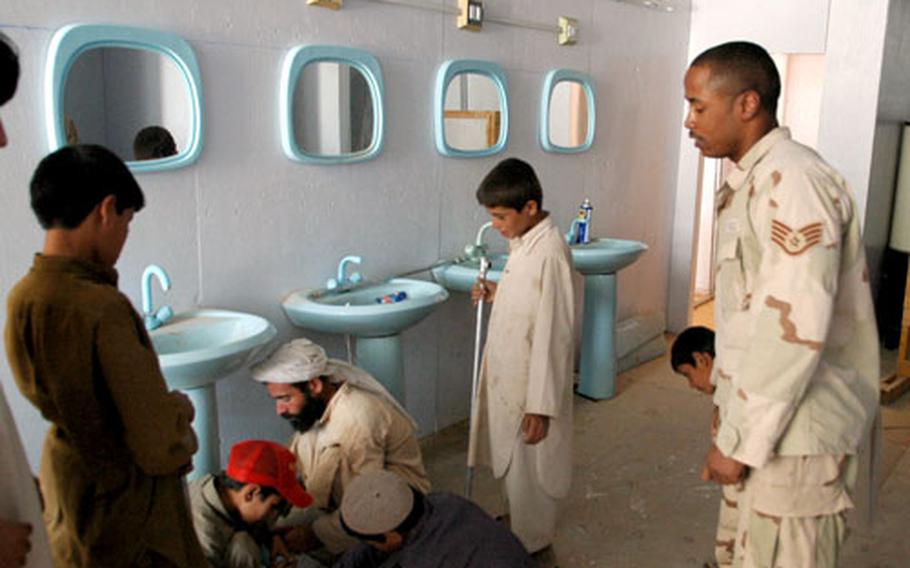Afghan students making strides, despite lack of basic education
Afghan students making strides, despite lack of basic education Stars and Stripes


Trade School Classes in Afghanistan

Staff Sgt. William Johnson directs students practicing their plumbing skills during classes Tuesday run by the Qalat provincial reconstruction team. (Leo Shane III / S&S)
Introduction
The Qalat provincial reconstruction team in southeastern Afghanistan has been conducting trade school classes for local Afghans. These classes aim to provide the foundation for a professional career and contribute to achieving the Sustainable Development Goals (SDGs).
Challenges in Education
One of the biggest challenges faced by the instructors is the low level of education among the Afghan population. Many students lack basic knowledge of subjects like biology and chemistry, making it difficult to teach advanced courses such as electrical work and nursing. The Taliban’s opposition to education has left many individuals with limited educational opportunities.
Computer Classes
Computer classes have been relatively successful, with about 80 students taking the available courses. Local instructors with knowledge of word processing and networking have taken over most of the teaching responsibilities. The students, many of whom are teenagers, have already qualified as entry-level technicians.
Electronics and Plumbing Classes
In the electronics and plumbing classes, students have learned practical skills such as installing lighting fixtures, sinks, and mirrors. The instructors provide certification for their skills and equip them with basic electrical and plumbing tools to help them find jobs in the community.
Auto Repair and Welding Classes
The auto repair shop and welding classes have also reported success and enthusiasm among the students. However, the education gap between the average Afghan and U.S. servicemembers can lead to confusion and frustration.
Nursing and EMT Classes
The nursing and EMT classes face similar challenges due to the education difference between the Afghan students and the U.S. instructors. However, efforts are being made to teach students who are still in school and have better literacy skills.
Conclusion
The trade school classes conducted by the Qalat provincial reconstruction team have made significant progress in providing vocational training to local Afghans. Despite the challenges posed by the low level of education, efforts are being made to bridge the gap and empower individuals to find employment opportunities in their communities.
SDGs, Targets, and Indicators
1. No Poverty
– Target 1.4: By 2030, ensure that all men and women, in particular the poor and the vulnerable, have equal rights to economic resources, as well as access to basic services, ownership, and control over land and other forms of property, inheritance, natural resources, appropriate new technology, and financial services including microfinance.
– Indicator 1.4.2: Proportion of total adult population with secure tenure rights to land, with legally recognized documentation and who perceive their rights to land as secure, by sex and by type of tenure.
4. Quality Education
– Target 4.3: By 2030, ensure equal access for all women and men to affordable and quality technical, vocational, and tertiary education, including university.
– Indicator 4.3.1: Participation rate of youth and adults in formal and non-formal education and training in the previous 12 months, by sex.
8. Decent Work and Economic Growth
– Target 8.2: Achieve higher levels of economic productivity through diversification, technological upgrading, and innovation, including through a focus on high-value added and labor-intensive sectors.
– Indicator 8.2.2: Annual growth rate of real GDP per employed person.
9. Industry, Innovation, and Infrastructure
– Target 9.3: Increase the access of small-scale industrial and other enterprises, particularly in developing countries, to financial services, including affordable credit, and their integration into value chains and markets.
– Indicator 9.3.1: Proportion of small-scale industries in total industry value added.
10. Reduced Inequalities
– Target 10.2: By 2030, empower and promote the social, economic, and political inclusion of all, irrespective of age, sex, disability, race, ethnicity, origin, religion or economic or other status.
– Indicator 10.2.1: Proportion of people living below 50 percent of median income, by age, sex, and persons with disabilities.
17. Partnerships for the Goals
– Target 17.17: Encourage and promote effective public, public-private and civil society partnerships, building on the experience and resourcing strategies of partnerships.
– Indicator 17.17.1: Amount of United States dollars committed to public-private partnerships.
Table: SDGs, Targets, and Indicators
| SDGs | Targets | Indicators |
|---|---|---|
| No Poverty | 1.4: By 2030, ensure that all men and women, in particular the poor and the vulnerable, have equal rights to economic resources, as well as access to basic services, ownership, and control over land and other forms of property, inheritance, natural resources, appropriate new technology, and financial services including microfinance. | 1.4.2: Proportion of total adult population with secure tenure rights to land, with legally recognized documentation and who perceive their rights to land as secure, by sex and by type of tenure. |
| Quality Education | 4.3: By 2030, ensure equal access for all women and men to affordable and quality technical, vocational, and tertiary education, including university. | 4.3.1: Participation rate of youth and adults in formal and non-formal education and training in the previous 12 months, by sex. |
| Decent Work and Economic Growth | 8.2: Achieve higher levels of economic productivity through diversification, technological upgrading, and innovation, including through a focus on high-value added and labor-intensive sectors. | 8.2.2: Annual growth rate of real GDP per employed person. |
| Industry, Innovation, and Infrastructure | 9.3: Increase the access of small-scale industrial and other enterprises, particularly in developing countries, to financial services, including affordable credit, and their integration into value chains and markets. | 9.3.1: Proportion of small-scale industries in total industry value added. |
| Reduced Inequalities | 10.2: By 2030, empower and promote the social, economic, and political inclusion of all, irrespective of age, sex, disability, race, ethnicity, origin, religion or economic or other status. | 10.2.1: Proportion of people living below 50 percent of median income, by age, sex, and persons with disabilities. |
| Partnerships for the Goals | 17.17: Encourage and promote effective public, public-private and civil society partnerships, building on the experience and resourcing strategies of partnerships. | 17.17.1: Amount of United States dollars committed to public-private partnerships. |
Behold! This splendid article springs forth from the wellspring of knowledge, shaped by a wondrous proprietary AI technology that delved into a vast ocean of data, illuminating the path towards the Sustainable Development Goals. Remember that all rights are reserved by SDG Investors LLC, empowering us to champion progress together.
Source: stripes.com

Join us, as fellow seekers of change, on a transformative journey at https://sdgtalks.ai/welcome, where you can become a member and actively contribute to shaping a brighter future.







